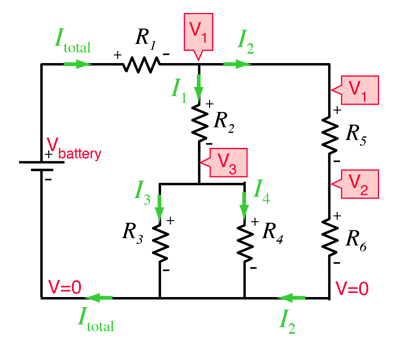DC Circuit Example
This is a collection of resistors driven by a battery which can be used as an exploration exercise in combining resistors and applying the basic tools for DC circuits such as the voltage law and the current law.
 |
The equivalent resistance is Requivalent = Ω.
If the battery voltage is VB = V
then the total current is Itotal = A.
Having found the equivalent resistance and current, the circuit can now be completely analyzed, specifying current and voltage at any point in the circuit. With repeated applications of the voltage law, current law and Ohm's law, the voltages at the indicated voltage probe points are
| V1 = V, V2 = V, V3 = V |
and the branch currents are
| I1 = A, I2 = A, I3 = A, I4 = A, |
Note: To avoid dealing with so many short circuits, any resistor with value zero will default to 1 when a voltage is changed. It can be changed back to a zero value if you wish to explore the effects of short circuits. Ohms and amperes are the default units, but if you put in resistor values in kilohms, then the currents will be milliamperes.
| DC circuit examples |
DC Circuits
| HyperPhysics***** Electricity and Magnetism | R Nave |